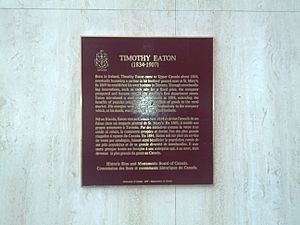Timothy Eaton facts for kids
Quick facts for kids
Timothy Eaton
|
|
|---|---|
 |
|
| Born | March 1834 Ballymena, County Antrim, Ireland
|
| Died | 31 January 1907 (aged 72) Toronto, Ontario, Canada
|
| Resting place | Mount Pleasant Cemetery, Toronto |
| Known for | Founder of Eaton's |
| Spouse(s) | Margaret Wilson Beattie |
| Children | 8 |
| Relatives | Eaton family |
| Signature | |
Timothy Eaton (born March 1834 – died January 31, 1907) was a smart businessman from Ireland. He started a famous store called Eaton's in Canada. This store became one of the biggest and most important shopping businesses in Canadian history!
Contents
Timothy Eaton's Early Life
Timothy Eaton was born in March 1834 in Ballymena, Ireland. His parents were John and Margaret Eaton. When he was 20, Timothy was learning to be a shopkeeper. He decided to move from Ireland to southern Ontario, Canada. He joined other family members who had already settled there.
On May 28, 1862, Timothy Eaton married Margaret Wilson Beattie. They had eight children together. They had five sons and three daughters. One of their daughters, Josephine Smyth Eaton, survived the sinking of the ship RMS Lusitania in 1915.
Starting the Eaton's Store

In 1854, Timothy Eaton worked briefly in a clothing store in Glen Williams, Ontario. Later, in 1865, he tried to start a bakery business. He had help from his brothers, Robert and James. However, the bakery in Kirkton, Ontario closed after only a few months. But Timothy didn't give up! He then opened a dry goods store in St. Marys, Ontario.
In 1869, Timothy Eaton bought a dry-goods and clothing store in Toronto. It was located at 178 Yonge Street. When he opened his new business, Eaton introduced two big ideas that were new at the time:
- All items had one set price. This meant no haggling or bargaining.
- Customers could not buy on credit. They had to pay right away.
- All purchases came with a money-back guarantee. If you weren't happy, you could get your money back! This became the store's famous slogan: "Goods Satisfactory or Money Refunded."
Eaton's Mail-Order Catalogue
Starting in 1884, Eaton's introduced something amazing to Canada: the mail-order catalogue. This catalogue was like a giant shopping book. It reached thousands of small towns and farms across the country. People in these areas could now buy things they couldn't find in their local stores.
The arrival of the Eaton's catalogue was a huge event in many small communities. It offered everything from clothes and furniture to kitchen gadgets. You could even find practical items like milking machines! The catalogue made shopping easier for many Canadians.
Eaton's Legacy and Impact

Timothy Eaton built a huge shopping business. His family continued to grow it across Canada. The company reached its peak during World War II. At that time, T. Eaton Co. Limited employed over 70,000 people!
Timothy Eaton didn't invent the idea of a department store. He also wasn't the first to offer a money-back guarantee. However, his store made both of these ideas very popular. He changed how people shopped in Canada forever.
Timothy Eaton passed away from pneumonia on January 31, 1907. He is buried in Mount Pleasant Cemetery, Toronto in Toronto. His son, John Craig Eaton, took over the business after him.
In 1919, employees of Eaton's gave two life-sized statues of Timothy Eaton to the Toronto and Winnipeg stores. This was to celebrate the company's 50th anniversary. For many years, it was a tradition for customers to rub the statue's toe for good luck. Today, the Toronto statue is at the Royal Ontario Museum. The Winnipeg statue is in the city's arena, Canada Life Centre. People still rub Timothy Eaton's toe for good luck!
Several places and buildings were named after Timothy Eaton:
- The town of Eatonia, Saskatchewan was named after him.
- The sports grounds of Ballymena RFC in Ireland are called Eaton Park.
- A school in Toronto, Timothy Eaton Business and Technical Institute, was also named in his honor. It opened in 1971 and closed in 2009.
See also
- Robert Simpson (merchant)
- John Wanamaker


